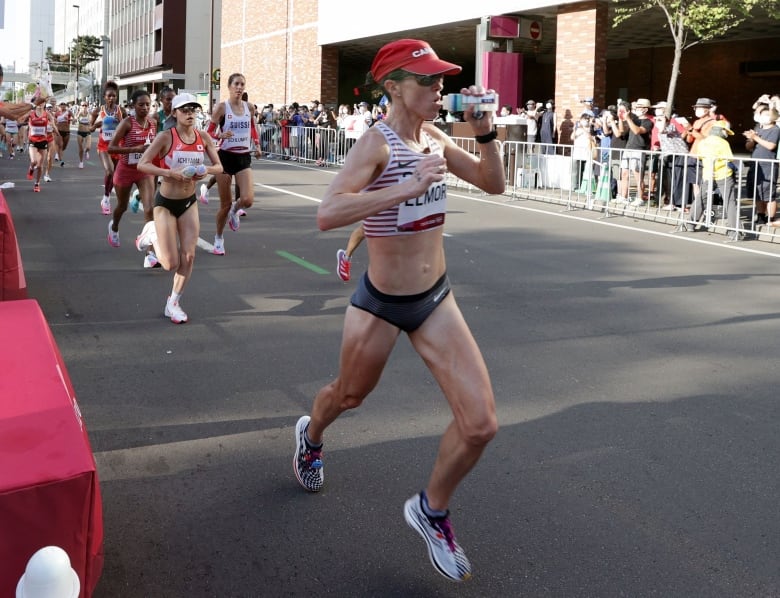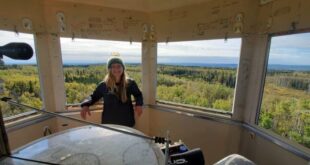Plan to exercise at the best times and locations, wear a mask or work out indoors, advises expert

For 15 years, Joanna Brown competed around the world at the highest level of triathlon, but near the end of her time competing she required a training adaptation she had little idea she would ever need: checking air quality before deciding on her workout.
Brown, 30, grew up near Ottawa and represented Canada at the 2020 Tokyo Olympic Games in the summer of 2021.
In August 2018, she had an unsettling experience over how climate change could disrupt her sport: she arrived in Kelowna to compete in the national championships, which were cancelled due to wildfire smoke from the province's 560 burning forest fires.
"The smoke was so bad," she said. "It was my first real exposure to wildfire smoke and air pollution and growing up in Ontario, it was never really an issue for us."
Since then, learning to adapt her training to consider extreme heat — which causes harmful amounts of ozone at ground level — and other air pollution, such as that caused by wildfire smoke, has become part of her routine.

While almost every resident in a province like B.C. is affected by periods of poor air quality exacerbated by extreme heat or wildfires, people committed to sports and physical performance are finding ways to try and safely continue doing what they love.
"It's hard, you want to be outside and doing all the things that you love but you don't really know what the effects are on your lungs and immune system and everything else," said Brown from Kelowna, where she moved after retiring from competition following the Tokyo games.
"I think that's the real scary part for me."
Long-term exposure to air pollution has been linked to heart and lung disease, and even dementia.
Brown still does plenty of running and mountain biking, but checks an air quality app before deciding on her outdoor activities.
"It's kind of become a nervous tick of mine," she said.
If the air quality index (AQI) on her app is below 150, she typically exercises outside. She calls an AQI of 150-200 her "grey zone," where she may not exert herself outdoors, choosing a gym workout instead or a walk while wearing an N95 mask.

An AQI of 150 is unhealthy for people sensitive to pollutants.
"I try to really limit my exposure when it's bad, but mental health is important too," she said about balancing exposure to bad air and benefits of daily exercise.
B.C. and other jurisdictions also use what is called the Air Quality Health Index, which combines health risks posed by a mixture of pollutants and has a scale of 1 to 10+.
Strategies for outdoor exercise
Dr. Michael Koehle, a physician who works with Athletics Canada, studies the effects of air pollution on performance and health at the University of British Columbia in Vancouver.
"We're not going to be able to avoid this stuff in the future, we better come up with strategies to manage it," he said.
In January, he along with other leaders in the field published a consensus statement in the British Journal of Sports Medicine reviewing the current science over how to train and compete in polluted air.
It highlighted the need for further study but provided several adaptations, which include limiting overall exposure to air pollution, taking antioxidant supplements such as Vitamin C in the lead-up to competitions, and even doing acclimation for some pollutants such as ozone.
It's something Malindi Elmore worked on with Koehle for the Tokyo Olympics marathon in 2021, which was held under hot and humid conditions and high levels of ground-level ozone.

Athletes like Elmore, 43, who lives in Kelowna, trained in Japan under those conditions for three weeks before competing. Studies show the body could lessen its inflammatory response to the pollutant over a period of exposure.
Elmore said being ready for that race, where she finished ninth, required several adaptation strategies beyond being fit and healthy.
"Really respecting the conditions … managing your effort and managing your hydration, fuelling, cooling strategies were [just] as important as overall fitness and race strategy," she said.
Still, Koehle said, exposure to air pollution is harmful and we won't get used to it, despite best practices for coping.
"It's horrible for you. It's going to shorten our lives, every time we get these wildfires seasons, it's going to cause disease."
His best advice is to reduce exposure to air pollution as much as possible: planning to exercise at the best times and locations, wearing a mask, or taking it inside.
"The most important and maybe easiest to execute strategy is really monitoring and planning around time and space," he said.
Elmore, who is planning a fall marathon in the Pacific Northwest ahead of next year's Paris Olympics, said she's hopeful she will be able to cope with what smoke may still come this year.
"You just don't know so you just have to kind of be open that things could change and fortunately I've never had a situation yet where it's been a really negative impact on my training," she said.
"But it's a risk."
*****
Credit belongs to : www.cbc.ca
 MaharlikaNews | Canada Leading Online Filipino Newspaper Portal The No. 1 most engaged information website for Filipino – Canadian in Canada. MaharlikaNews.com received almost a quarter a million visitors in 2020.
MaharlikaNews | Canada Leading Online Filipino Newspaper Portal The No. 1 most engaged information website for Filipino – Canadian in Canada. MaharlikaNews.com received almost a quarter a million visitors in 2020.







